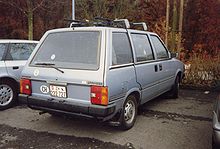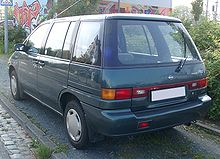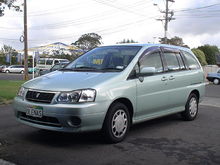Nissan Prairie
The Datsun Prairie (Nissan Prairie) was the first medium-class van built worldwide and was built in three generations by the Japanese company Nissan from autumn 1981 to the end of 2004. It was originally launched as Datsun Prairie. After Nissan stopped exporting the Datsun brand (also in Japan at the end of the 1980s), it was offered as Nissan Prairie. In Europe, Nissan only offered the first two series and took the model out of the range in mid-1994.
The Prairie is a spacious high-roof station wagon with side sliding doors for the second row of seats, which would be called a compact van today . Towards the end of the 1990s, the high roof concept was adopted by many other manufacturers. These include, for example, the models Citroën Xsara Picasso , VW Touran , Opel Zafira and Kia Carens . Only with the Nissan Almera Tino was there another successor to the Prairie for the European market in the summer of 2000.
Prairie (M10, 1981-1988)
The first generation of the Prairie was introduced in Japan in the fall of 1981, in Europe in late summer 1982 and in North America in 1986. In Canada it was called Nissan Multi , in the USA it was called Nissan Stanza Wagon .
The technique was adopted from the Datsun Stanza . The Prairie was powered by a four-cylinder engine installed transversely at the front and a front-wheel drive , optionally also with an electrically switchable rear-wheel drive (Prairie 4x4 ). The Nissan Prairie M10 is characterized by its short length, so it is only 10 cm longer than a VW Golf 2 , but still offers enough space for a family of five. The first model series came up with some idiosyncrasies. The windows in the sliding doors could only be lowered by about a third due to the rear wheel arches. The window cranks closed with spring pressure so that they weren't in the way when the sliding door was opened. The handbrake was not anchored in the ground, but above the car radio. It therefore had to be pulled horizontally and released again by turning. The car radio, on the other hand, was mounted close to the floor and was not accessible in a normal sitting position. The rear seat bench was arranged in such a way that long objects could easily be pushed under it, making roof structures for skis superfluous. Furthermore, the prairie did not have a B-pillar.
The parallels between the current Nissan Note and the Nissan Prairie are unusual: it has the same length (approx. 4.09 m), the same trunk volume (but with the rear seat extended) and, in the weakest version, the same engine output (88 hp or 65 kW).
Despite its rarity, the Prairie managed to play a role in the 1985 film Die Einsteiger by Thomas Gottschalk and Mike Krüger.
Production of the first series was ended in autumn 1988.
Prairie (M11, 1988-1998)
The second version, available from autumn 1988 ( called Nissan Axxess in the USA ), had a much more modern design and was available with either front-wheel drive or permanent all-wheel drive. The European version was called Nissan Prairie Pro and was manufactured by the Spanish Nissan Motor Ibérica . The Nissan Prairie Air Pro version with air conditioning was also available.
In Europe, the Prairie Pro was taken out of stock in the summer of 1994 due to a lack of demand.
In Japan there was another variant in the model range parallel to the ordinary Prairie, which was called Nissan Prairie Joy .
Prairie Liberty (M12, 1998-2004)
For the Japanese market there was a successor to this series, which was marketed as the Nissan Prairie Liberty .




